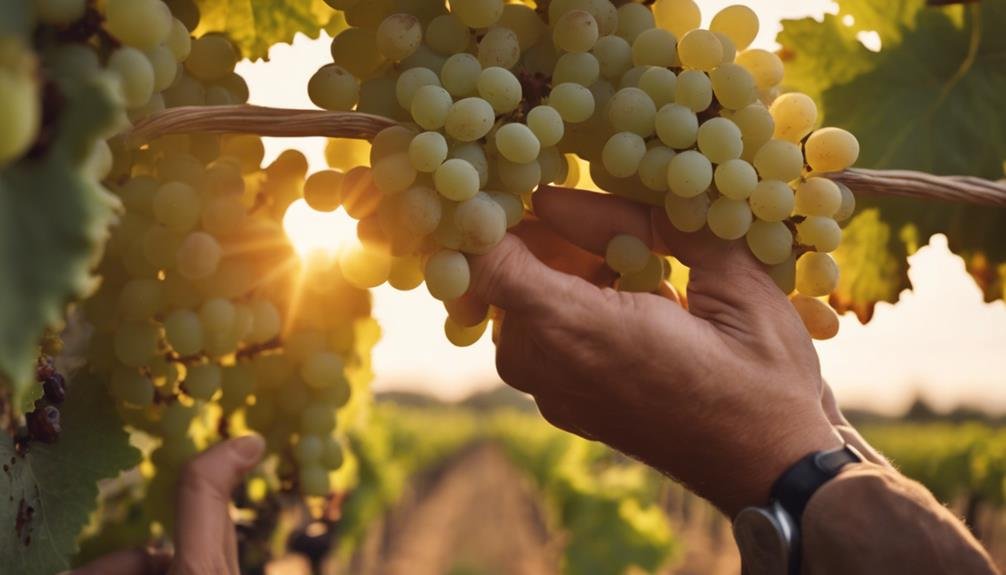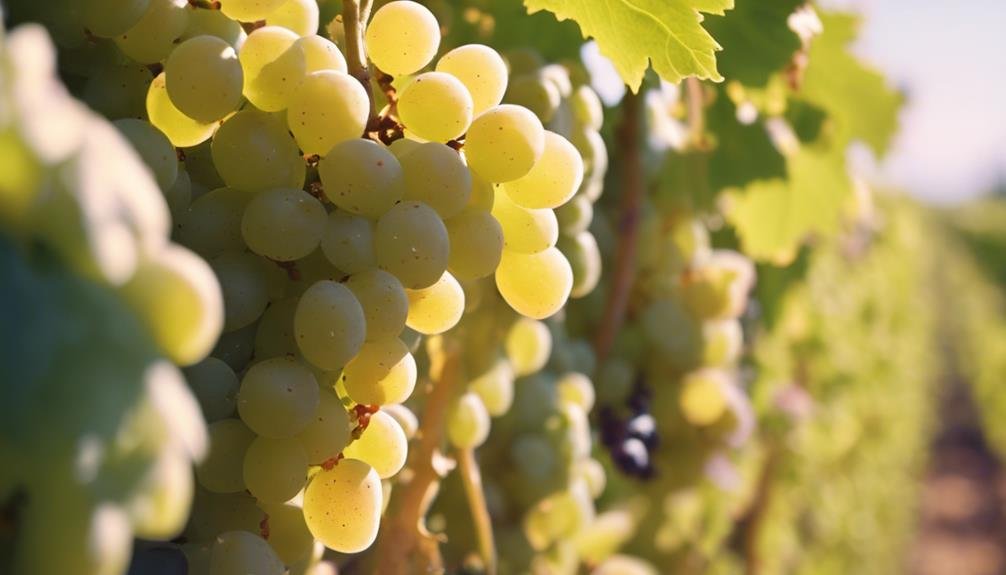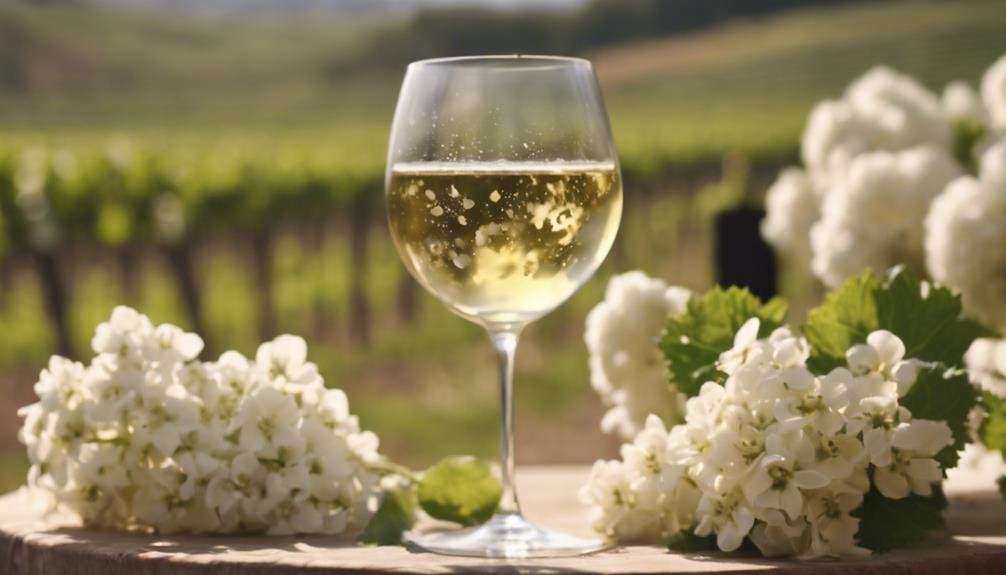Viognier has made a remarkable comeback, from the brink of extinction to a celebrated white wine today. Its unique floral aromas and fruity flavors have been pivotal in its resurgence, enchanting wine enthusiasts globally. French Viognier is known for its intense floral scents like honeysuckle, a full-bodied texture, and vibrant acidity. Despite challenges in cultivation due to its demanding nature and sensitivity to climate and soil, Viognier from Côte Rôtie stands out with delicate floral notes and a harmonious blend of flavors. Perfect for spring pairings, Viognier embodies fragrant success, ideal for those who appreciate floral elegance. Subtly explore more about this fascinating varietal.
History of Viognier
Viognier’s history is a tribute to its remarkable journey from the brink of extinction 50 years ago to becoming a celebrated perfumy white wine today. This revival story is a fascinating one, with Viognier’s unique flavor profiles playing a significant role in its resurgence.
Known for its floral aromas and rich, fruity flavors, Viognier offers a sensory experience unlike any other white wine. The grape’s ability to produce wines with notes of peach, apricot, and honeysuckle has captivated wine enthusiasts worldwide.
This distinctiveness, coupled with its resurgence in popularity, has solidified Viognier’s place as a cherished varietal in the world of wine. Its journey from obscurity to fame is a tribute to the grape’s resilience and the allure of its enticing flavor profiles.
Characteristics of French Viognier
French Viognier from the Rhône Valley showcases an explosively floral and rich profile that distinguishes it as a prominent player in the world of white wines. The characteristics of French Viognier include:
- Aromas: French Viognier is renowned for its intense floral aromas, often reminiscent of honeysuckle, jasmine, and orange blossom.
- Texture: The wine exhibits a luscious and full-bodied texture that coats the palate, providing a luxurious mouthfeel.
- Acidity: Despite its richness, French Viognier maintains a vibrant acidity that balances the floral richness, adding freshness to the wine.
- Age-Worthiness: High-quality French Viognier from regions like Condrieu and Côte Rôtie can age gracefully, developing complex flavors of dried fruits and nuts while retaining its floral essence.
Challenges in Growing Viognier

Growing Viognier presents unique challenges due to its fickle nature and low yields, requiring careful attention and expertise from vineyard managers and winemakers alike. Viognier is known for being unpredictable in its growth patterns, making it a demanding grape to cultivate. Its fickle nature means that it is sensitive to changes in climate, soil conditions, and pests, necessitating constant monitoring and adjustments in the vineyard.
Additionally, Viognier typically produces low yields compared to other grape varieties, making it less economically viable for some growers. This can be frustrating for vineyard managers who must balance quality and quantity when cultivating Viognier. Despite these challenges, the distinct aromas and flavors of Viognier make it a sought-after wine, driving winemakers to overcome these obstacles to produce this fragrant and flavorful varietal.
Viognier From Côte Rôtie
Renowned for its delicate floral notes and unique balance of body and alcohol, Viognier from Côte Rôtie exemplifies the artistry and complexity of this esteemed white wine varietal.
- Floral Elegance: Viognier from Côte Rôtie showcases a distinct floral elegance, with aromas of honeysuckle, apricot, and violet that captivate the senses.
- Regional Influence: The terroir of Côte Rôtie, characterized by steep slopes and granite soils, imparts a minerality and structure to Viognier, enhancing its overall complexity.
- Complexity and Depth: Viognier from Côte Rôtie offers a harmonious blend of floral and fruity flavors, coupled with a rich texture and a lingering finish that sets it apart.
- Cellaring Potential: Due to its robust structure and acidity, Viognier from Côte Rôtie has the potential to age gracefully, evolving in complexity and developing unique secondary characteristics over time.
Viognier for Spring

As spring ushers in its vibrant warmth and renewal, the allure of Viognier’s fragrant bouquet and robust body becomes particularly enticing for wine enthusiasts seeking a seasonal delight. Viognier is perfect for spring pairings, offering floral aromas that complement the season’s ambiance. Its powerful body and delicate floral notes give the feeling of drinking in the sun and breeze of spring.
Beyond France, exploring Viognier from regions like California, Australia, and Italy can be intriguing for those interested in wine education. Whether enjoyed on its own or paired with light spring dishes, Viognier’s unique characteristics make it a great choice for anyone looking to savor the essence of spring in a glass.
Frequently Asked Questions
How Does Viognier Compare to Other White Wines in Terms of Acidity?
Viognier distinguishes itself from other white wines with its moderate acidity, offering a balance that enhances its sweetness. Originating from France, Viognier’s texture is lush and its versatility shines in various winemaking regions, making it a delightful choice for wine enthusiasts.
What Food Pairings Work Best With Viognier Wines?
Known for its rich floral and fruity aromas, Viognier pairs well with a variety of dishes. Its versatility shines with spicy Asian cuisine, creamy pasta dishes, and seafood like scallops. Viognier’s vibrant acidity complements these flavors, enhancing the dining experience.
Are There Any Specific Wineries Known for Exceptional Viognier Production?
Viognier pioneers have pushed boundaries in emerging regions like California’s Central Coast and South Africa’s Stellenbosch. Wineries known for exceptional Viognier production include Alban Vineyards and Tablas Creek. These establishments showcase the grape’s versatility and quality.
How Does the Aging Process Impact the Flavors of Viognier Wines?
Aging Viognier in oak barrels enhances its flavors by imparting notes of vanilla, spice, and toast. This process also allows for the development of aromatic complexity, revealing the wine’s full potential, making it a delightful experience for wine enthusiasts.
Can Viognier Be Used in Blending With Other Grape Varieties?
Viognier can be used in blending with other grape varieties to enhance flavor profiles and complexity in wines. Winemaking techniques vary, with regional varietals complementing Viognier’s fragrant characteristics. Consider exploring unique blends for a rich tasting experience.
Conclusion
In the enduring tale of Viognier’s revival, this fragrant varietal has bloomed from the brink of disappearance to a celebrated status in the world of wine. Like a delicate flower that perseveres through harsh conditions, Viognier’s journey is a demonstration of resilience and appreciation.
As enthusiasts continue to savor its unique characteristics, Viognier stands as a symbol of beauty and strength, embodying the essence of a true success story in the domain of winemaking.
